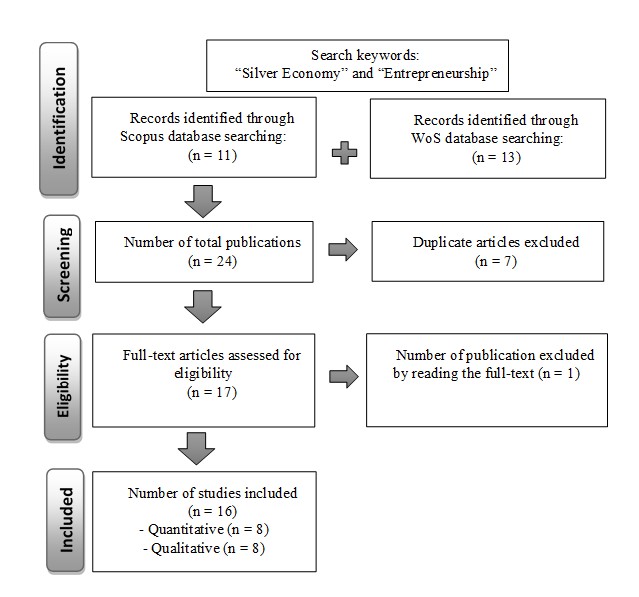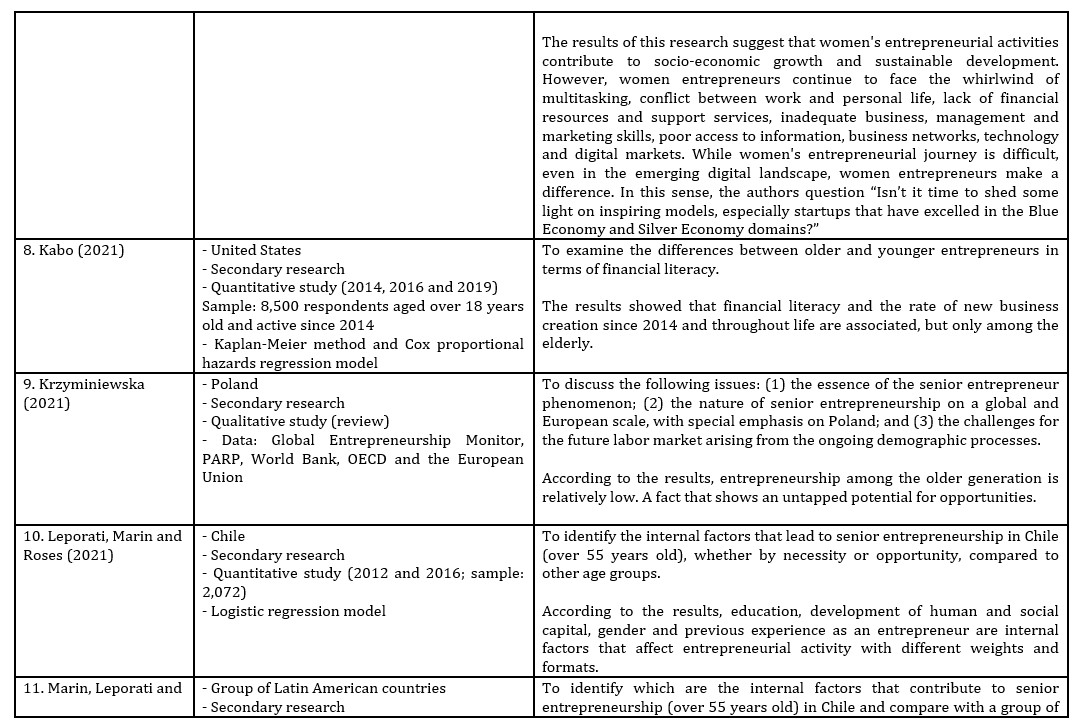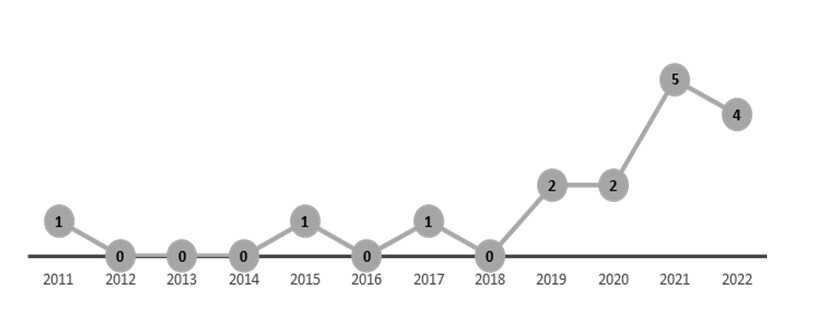Introduction
In the last decade, there has been a growing interest in the area of research related to the entrepreneurial capacity of the elderly, given the weight and importance of this segment of the population for the economic and social development of their countries (Marin, Leporati, & Roses, 2020). Arkebauer (1995) defines a senior entrepreneur as one who is over 50 years old and who owns a business, regardless of its size. According to Kautonen (2013), the term senior entrepreneur generally refers to people aged 50 years old or over, who are planning or in the process of starting or have recently started a business.
The concept of Silver Economy or longevity economy emerged more than a decade ago, as a consequence of demographic change, more expressive in developed countries, associated with increased life expectancy and low birth/fertility rates (Maâlaoui, & Razgallah, 2019; Butt, Rava, Kangilaski, Pappel, & Draheim, 2021). The progressive aging of the population is one of the main current challenges for the economy of modern countries around the world, with important economic and social consequences (Podgórniak-Krzykacz et al., 2020).
Oriented towards the population over 50 years old, it promotes the development and marketing of innovative products and services aimed at elderly consumers (Rachwał, 2011), promoting, on the one hand, a healthy and active life style and, on the other hand, an active participation of the elderly at work, as employees, entrepreneurs or consultants. In this sense, building the competitiveness of the economies of countries with the most accentuated population aging processes is becoming one of the greatest challenges in contemporary society (Krzyminiewska, 2021).
Identified as a potential domain for business growth and opportunities around the world, especially in developed countries where demographic change has been most significant (Butt, & Draheim, 2021), the Silver Economy’s biggest concern is establishing an economic sustainable strategy, taking advantage of the career potential of the elderly (Briegas, Castro, Iglesias, Lucchese, & Ballester, 2021).
The rise of entrepreneurship in this demographic has a direct impact on the wealth and well-being of societies (Marin, Leporati, & Roses, 2020). Keeping the elderly as part of the workforce generates positive effects on the economy, on the health system (Heimonen, Närhi, Kauppi, & Gustafsson-Pesonen, 2012), and decreases age-related public spending, especially with regard to the health system, pensions and public expenditure associated with long-term health care (Kurek, & Rachwał, 2011; Oelckers, 2015).
Senior entrepreneurship can be seen from two perspectives. On the one hand, senior entrepreneurs are more innovative and, on the other hand, they seem to have more socially oriented goals in the performance of their ventures, which they fulfil in the form of social entrepreneurship (Stumbitz, 2013). Bild (2018) argues that the elderly are a very valuable resource for the labor market and for entrepreneurial activity as the elderly are particularly well positioned, in terms of access to resources and knowledge. Experience grows with age and seniors develop skills through effective lifelong learning (Kurek, & Rachwał, 2011).
In addition, many of the elderly have physical and mental capacity, motivation, need, energy and the desire to continue working (Oelckers, 2015; Stephens, & Hegarty, 2022). When the stability of the financial situation is controlled, entrepreneurship and self-actualization attitudes explain well-being in old age (Viljamaa, Joensuu-Salo, & Kangas, 2022). However, in the opinion of Fachinger (2019), the potential of older people is underutilized. So, to obtain the best use of their potential, it is essential to support and encourage actions that allow the creation of viable businesses, keeping the elderly active and participatory in the society. These supports and incentives offer older citizens the opportunity to supplement low pensions, or provide some additional income when this is not available (Wainwright, & Kibler, 2013).
Furthermore, it increases employment, growth and opportunities for older people to work on service and product solutions adapted to their needs (Kamberidou, 2020), which has the consequence of increasing the productivity of traditional sectors of the economy and, in particular, of the most innovative sectors associated with the modern digital economy (Govorova, 2021). According to Stypinska, Franke and Myrczik (2019), senior entrepreneurs contribute to the creation of new innovative solutions for unemployment, underemployment, social exclusion or poverty.
In view of the above, the research paradigm on the Silver Economy presupposes reflecting on how the potential of the elderly can be used and what is the appropriate policy to implement so that their professional activity is prolonged and, in this way, active and inclusive aging is promoted (Kamberidou, 2020). Given the impact of population aging on entrepreneurship development and the rise of the Silver Economy, Rachwał (2011) and Viljamaa, Joensuu-Salo and Kangas (2022) argue that policymakers should encourage senior entrepreneurs to continue to work after retirement promoting a climate marked by a positive attitude towards entrepreneurship in the elderly.
Despite its importance, midlife entrepreneurship is currently an underdeveloped area of research (Ratten, 2019). In this context, the main objective of this study was to investigate the current status of a particular aspect of Silver Economy, the senior entrepreneurship, based on the Preferred Reporting Items for Systematic Reviews and Meta-Analyses (PRISMA) statement.
This article is organized into four sections. In the first section, the literature review is organized, the objective is presented, the methodology used is briefly described and the structure of the article is presented. The second section describes with more detail the methodology used. The third section presents and discusses the results including detailed content analysis. Finally, the fourth and last section presents the main conclusions and suggests guidelines for future research.
Methods
From a methodological point of view, a systematic review of the literature was carried out, which enabled data collection and subsequent analysis. For this, some criteria were defined that allow the collection of data in a reliable and replicable way (Xiao, & Watson, 2019) making the literature review process scientific and transparent (Tranfield, Denyer, & Smart, 2003).
The present systematic literature review was based on the PRISMA statement (Moher, Liberati, Tetzlaff, & Altman, 2009). In this context, the Scopus and Web of Science (WoS) databases were screened. The searches were performed in October 22, 2022, using the keywords “Silver Economy” and “Entrepreneurship”. A total of twenty-four documents were found (Scopus: 11 documents; WoS: 13 documents), as shown in Figure 1. Of these, seven publications were removed because they were duplicated in both databases. Therefore, seventeen publications were taken into consideration for reading and analysis. Finally, the entire text was selected, in order to verify the relevance of the publications for this research, considering the following criteria: studies that include retired individuals following an entrepreneurial journey. After the complete reading of the publications, the study developed by Pauhofova and Palenik (2012) was withdrawn. In fact, despite being related to the Silver Economy and having as objective to know the potential of the demand of seniors in the European Union (EU), this research only analyses the publications from the producer’s perspective. Then, for the sixteen publications selected, it was collected information about authorship and publication date, place (country) where the research took place, type of study, methodology used, objectives of the study and findings.

Fig 1. PRISMA flow diagram of data collection process and analysis
Results and Discussion
Table 1 presents all the included publications by ascending order of publication date. The table also contains information about authorship, type of study, country where the research was developed, sample size, objectives and contributions. The selected studies were developed in America (United States and Latin America), Asia (Jordan), Europe (Finland, France, Greece, Ireland, Poland, Portugal, Romania, Spain, Serbia, Slovenia, Sweden and United Kingdom) and Oceania (Australia). The study developed by Marin, Leporati and Roses (2021), included a group of eight Latin American countries, namely Argentina, Brazil, Chile, Colombia, Ecuador, Mexico, Peru and Uruguay. Lenihan and McGuirk (2022) developed an investigation involving the United States, Australia, and European countries, namely, Ireland, Finland, Spain, Portugal, France, Slovenia and Poland. The studies use, predominantly, secondary data (82.4%). Of the sixteen publications, 50% are quantitative and the remaining are qualitative research, with the majority being developed in the European continent, three in the European Union and thirteen in European countries, with Romania being the country where most studies were developed (23.5%).
Table 1: General data, objectives and findings of the articles selected for the systematic literature review 


Although, in 2022, only the first 10 months were considered for analysis, this year almost equals the number of publications in 2021, the year with the highest number of published documents (4 out of 16). From 2011 to 2021 there was an average annual growth of 15.8% in the number of documents published (Figure 2).

Fig 2. Number of articles published per year
The publications included in this systematic literature review aimed to explore the association between the level and dynamics of population aging and the development of entrepreneurship in the senior population (Kurek, & Rachwał, 2011; Ivanić, 2019); investigate the concept of Silver Economy (Dragusin et al., 2017) and the phenomenon of senior entrepreneurship (Grosu, & Dragudin, 2020), its essence, nature, challenges (Kamberidou, 2020; Grosu, & Dragudin, 2020; Viljamaa, Joensuu-Salo, & Kang, 2022) and leadership styles (Kamberidou, 2020); identify the characteristics of entrepreneurship in the senior population segment (Kamberidou, 2020; Dragusin et al., 2017), thus contributing to a phenomenon with great potential, however, unexplored (Ivanić, 2019; Welsh, Dragusin, & Grosu, 2019).
Kabo (2021) identifies and analyses the differences between older and younger entrepreneurs with regard to financial literacy. Leporati, Marin and Roses (2021) and Marin, Leporati and Roses (2021) identify some internal factors (e.g., gender, training, among others) that affect entrepreneurial activity. ElTamimi and Sweis (2021) try to know the perceptions that individuals have about entrepreneurship and to know what is their impact on entrepreneurial intention. Lenihan and McGuirk (2022) highlight the potential of the elderly for companies and businesses, drawing the attention of the academic community to this subject, still little explored, given its importance and weight for the economic and social development of countries. Stephens and Hegarty (2022) report experiences of individuals who have followed an entrepreneurial journey after their retirement. Finally, Viljamaa, Joensuu-Salo and Kang (2022) determine and analyze the effects of motives and attitudes on the well-being and personal and professional fulfilment of entrepreneurs taking into account their age.
Conclusions
This research aimed to investigate the current status of the Silver Economy more specifically the active role of the elderly as entrepreneurs. Thus, a bibliographic search based on “Silver Economy” and “Entrepreneurship” keywords was carried out in the Scopus and WoS databases, in the period from 2011 to 2022, having selected sixteen articles. These articles show the importance of the elderly for the economic and social development of their countries and for that reason they appeal to the scientific and political communities to investigate and support the potential of these individuals, holders of physical and mental capacity, motivation, need, energy and desire to keep working, creating new innovative solutions for unemployment, underemployment, social exclusion or poverty.
Taking into account that secondary research is predominate, for future research it is suggested to develop more empirical research, with primary data collection, involving individuals who plan or are in the process of starting or have already started a new business, after retirement, with the objective of knowing the motivations (self-fulfillment, independence, financial stability, recognition, psychological well-being, among others) that lead them to follow the journey of entrepreneurship.
Acknowledgments
The authors are grateful to the Foundation for Science and Technology (FCT, Portugal) for financial support through national funds FCT/MCTES (PIDDAC) to CIMO (UIDB/00690/2020 and UIDP/00690/2020) and SusTEC (LA/P/0007/2020).
References
- Arkebauer, J.B. (1995). Golden Entrepreneuring: The Mature Person’s Guide to a Successful Business, McGraw-Hill, New York.
- Blid, L. (2018). ‘Senior entrepreneurship – key facts at regional level in Romania,’ Proceedings of the 12th International Conference on Business Excellence, 12 (1), 139-150.
- Briegas, J.J.M., Castro, F.V., Iglesias, A.I.S., Lucchese, F. and Ballester, F. (2021). ‘Silver economy a development opportunity,’ Confinia Cephalalgica, 31 (2), e2021015.
- Butt, S.A., and Draheim, D. (2021). ‘Ethical challenges of ICT for the silver economy,’ 2021 8th International Conference on eDemocracy and eGovernment, ICEDEG 2021, 152-155.
- Butt, S.A., Rava, K., Kangilaski, T., Pappel, I. and Draheim, D. (2021). ‘Designing a digital collaborative platform for the silver economy: Inception and conceptualization,’ 8th International Conference on eDemocracy and eGovernment, ICEDEG 2021, 47-54.
- Drăgușin, M., Sîrbu, M.O., Grosu, R.M. and Iosif, A.E. (2017). ‘Longevity/Silver Economy and Senior Entrepreneurship: The Case of Romania,’ BASIQ International Conference on New Trends in Sustainable Business and Consumption, 217-224.
- Drăgușin,, Welsh, D., Grosu, R.M., Iosif, A.E., and Zgura, I.D. (2015). ‘Social entrepreneurship – innovative solutions’ provider to the challenges of an ageing population: The case of Romanian retirees.’ Amfiteatru Economic, 17 (9), 1183-1197.
- Eager, B., Maritz, A. and Millemann, J. (2022). ‘The silver economy on wheels: a narrative review of the mature-aged, hypermobile gig worker phenomena,’ Small Enterprise Research, 29 (1), 68-85.
- ElTamimi, R.A. and Sweis, N.J. (2021). ‘The perceptions of individuals aged 50 years and older towards engaging in entrepreneurial activities,’ International Journal of Entrepreneurship and Small Business, 42 (4), 422-450.
- Fachinger, U. (2019). ‘Senior Entrepreneurship. Self-employment by Older People an Uncharted Territory,’ Zagreb International Review of Economics & Business, 22 (1), 95-106.
- Govorova, N. (2021). ‘The European Silver Economy,’ Sovremennaya Evropa, 106 (6), 109-119.
- Grosu, R.M. and Drăgușin, M. (2020). ‘Senior entrepreneurship in Romania: a quantitative approach,’ 6th BASIQ International Conference on New Trends in Sustainable Business and Consumption, 981-988.
- Heimonen, T., Närhi, M., Kauppi, J. and Gustafsson-Pesonen, A. (2012). ‘Entrepreneurship in golden years – Creative opportunity or not. School of Economics, Entrepreneurship, Small business Centre, Aalto University.
- Ivanić, V. (2019). ‘Active aging and prerequisites for silver entrepreneurship in Serbia,’ Stanovnistvo, 57 (1), 71-95.
- Kabo, F.W. (2021). ‘Effect of Financial Literacy on Starting a New Business: Using Survival Analysis to Examine. Differences between Older and Younger Entrepreneurs,’ Esic Market Economics and Business Journal, 52 (2), 343-372.
- Kamberidou, I. (2020). ‘“Distinguished” women entrepreneurs in the digital economy and the multitasking whirlpool,’ Journal of Innovation and Entrepreneurship, 9 (3), 1-26.
- Kautonen, T. (2013). Senior Entrepreneurship, OECD Centre for Entrepreneurship, SMEs and Local Development.
- Krzyminiewska, G. (2021). ‘The olderpreneur: future market challenges. Bulletin of Geography,’ Socio-economic Series, 51, 75–83.
- Kurek, S. and Rachwał, T. (2011). ‘Development of entrepreneurship in ageing populations of The European Union,’ Procedia – Social and Behavioral Sciences, 19, 397-405.
- Lenihan, A.C. and McGuirk, H. (2022). ‘Small enterprises and the silver economy,’ Small Enterprise Research,29 (1), 1-5.
- Leporati, M., Marin, A.J. and Roses, S. (2021). ‘Senior entrepreneurship in Chile: necessity or opportunity? A GEM perspective,’European Business Review, 33 (6), 892-917.
- Maâlaoui, A. and Razgallah, M. (2019). Handbook of Research on Elderly Entrepreneurship, Springer Nature, Switzerland.
- Marin, A.J.T., Leporati, M. and Roses, S.D. (2020). ‘Factors influencing senior entrepreneurship in Chile. A GEM perspective,’ Esic Market Economics and Business Journal, 52 (169), 313-342.
- Moher, D., Liberati, A., Tetzlaff, J. and Altman D. G. (2009). ‘The PRISMA Group: Preferred Reporting Items for Systematic Reviews and Meta-Analyses: The PRISMA Statement,’ PLoS Med 6 (7), e1000097.
- Oelckers, F. (2015). ‘Emprendimiento en la Tercera Edad: Una Revisión de la Situación Actual,’ Journal of Technology Management and Innovation, 10 (3), 143-153.
- Pauhofova, I. and Palenik, M. (2012). ‘Connections between European Population Aging and Domestic Demand Formation. Conference on Inequality and Poverty in the European Union and Slovakia, 33-38.
- Podgórniak-Krzykacz, A., Przywojska, J. and Warwas, I. (2020). ‘Silver economy as a response to demographic challenges in polish regions: realistic strategy or Utopia?,’ Innovation: The European Journal of Social Science Research, 1–28.
- Ratten, V. (2019). ‘Older entrepreneurship: a literature review and research agenda,’ Journal of Enterprising Communities: People and Places in the Global Economy, 13 (1/2), 173-195.
- Stephens, S. and Hegarty, C. (2022). ‘Retirees from public service: the journey to small enterprise ownership,’ Small Enterprise Research, 29 (1), 52-67.
- Stumbitz, B. (2013). Social Entrepreneurship Shaped by the Life Course: A Case Study of Older Social Entrepreneurs in the UK, Middlesex University, London.
- Stypinska, J., Franke, A. and Myrczik, J. (2019). ‘Senior Entrepreneurship: The Unrevealed Driver for Social Innovation,’ Frontiers in Sociology, 4, 1-16.
- Tranfield, D., Denyer, D. and Smart, P. (2003). ‘Towards a methodology for developing evidence informed management knowledge by means of systematic review,’ Brazilian Journal of Management, 14 (3), 207-222.
- Viljamaa, A., Joensuu-Salo, S. and Kangas, E. (2022). ‘Part-time entrepreneurship in the third age: well-being and motives,’ Small Enterprise Research, 29 (1), 20-35.
- Wainwright, T. and Kibler, E. (2013). ‘Beyond financialization: older entrepreneurship and retirement planning,’ Journal of Economic Geography, 14 (4), 849–864.
- Welsh, D.H.B., Drăgușin, M. and Grosu, R.M. (2019). Romania’s ageing population: Entrepreneurship opportunities and challenges, Handbook of Research on Entrepreneurship and Aging, Backman, M., Karlsson, C. and Kekezi, O. (ed.), 327-351.
- Xiao, Y. and Watson, M. (2019). ‘Guidance on conducting a systematic literature review,’ Journal of Planning Education and Research, 39 (1), 93–112.







